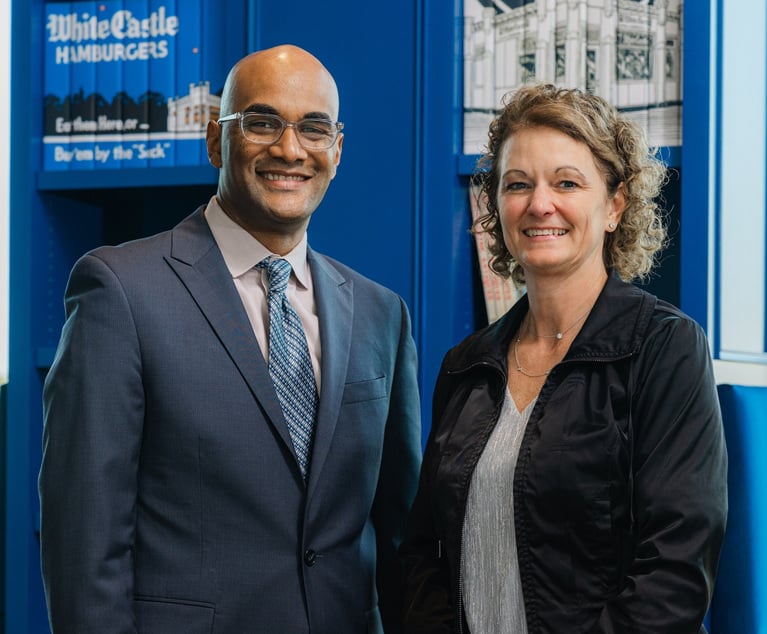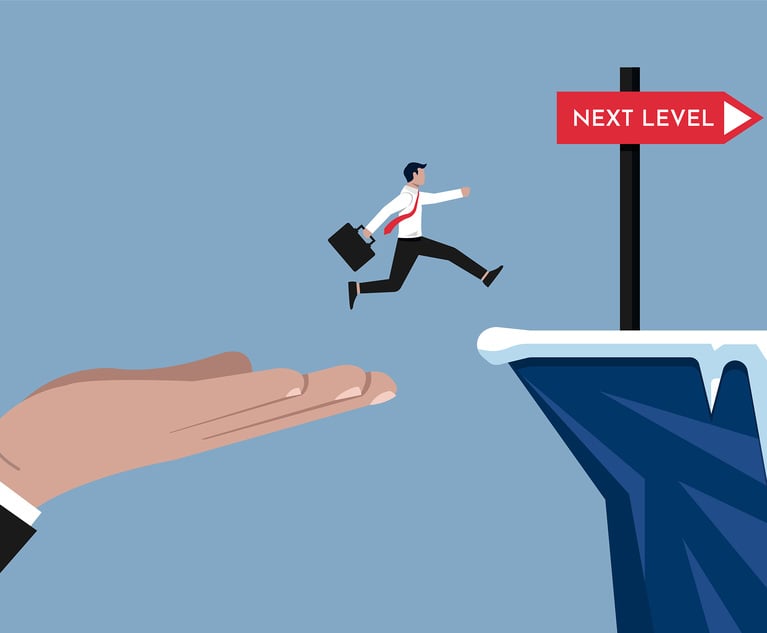Law School Reunion Goldmine
It's never too late to make valuable new friends.
May 09, 2010 at 08:00 PM
9 minute read
Reunion behavior tends to follow a predictable pattern. We connect with our closest friends from school and spend the majority of reunion weekends with the most familiar faces. Everyone else gets the awkward name tag stare down or, worse, a “Good to see you Steve,” only to be reminded that Steve's name is actually Shaun. Many people skip law school reunions to avoid such awkwardness or because they don't have good friends who are attending.
I encourage you to approach the reunion experience differently. Law school reunions are absolute goldmines for making new connections. We only really know a fraction of our classmates and we have lost touch with a good many over the years. At the same time, we know it's important to have strong networks in place for current or future job searches, for business development or for trusted peer level advice.
Here is how I prepared for my recently concluded 20th year law school reunion at Duke. I started by printing out the list of attendees a week before the reunion. Then I did a Google and LinkedIn search on classmates for whom I was not up-to-date. My brain is not big enough to memorize that much information, so I identified 10 individuals I really wanted to “meet” as if for the first time. In some cases the reason was mercenary; as in, this person is in a decision-making position at a potential client company. Others were people I liked in school but with whom I had completely lost touch. Many of the 10 people I identified overlapped both categories.
Then I did an environmentally unfriendly thing. I printed out as many current head shot photos as I could find, usually from LinkedIn or current employers' websites. I had fun studying these on the plane ride out to North Carolina.
At the reunion itself, I still spent a lot of time with my closest friends, jogging with them, dining with them, etc. It would have been a wonderful weekend if there was nothing more to it than that. But I made a concerted effort to jump from mini-group to mini-group and to not linger too long over any one cocktail conversation. My goal was to engage with as many people as possible. Accordingly, I still had a couple of those embarrassing moments when I could not remember a name. At a 20th year reunion, people tend to be forgiving on that score.
In those instances where I put my on-plane study to use, it paid off. When you recognize a face and know where someone works or lives, that person responds favorably. And you can quickly get into a conversation about the present, identifying areas of mutual interest. Personally, I enjoy talking about the present more than reminiscing about the past. From a networking standpoint, it's best to focus on what interests someone now, either personally or professionally. That's the subject matter on which you will build your follow-up.
As with any successful networking, the most important ingredient comes after the event. Online sites such as LinkedIn, Legal OnRamp and Martindale-Hubbell Connected are helpful starting points. Choose your favorite “social media” mechanism and use the connecting feature to say “great seeing you at the reunion” within a few days post-event.
Then, make some proactive decisions about people. Did you renew a friendship that you truly want to build as a friendship? If so, make real plans with that person to do something socially and put a date on the calendar. Who are your peers or potential clients with whom a business relationship makes sense (for them as well as for you)? Do something proactively nice for those individuals. Examples: sending useful information, extending an invitation to a relevant seminar, supporting a charitable cause in which the person is active, etc. Give before you ask to get. Building a relationship takes time.
Do this well, and these are the folks who will go to bat for you when you need a powerful referral or recommendation. And don't be surprised when they reach out to you out of the blue with great ideas and business opportunities. These are your classmates, after all. The success of each classmate reflects well on the others. I think I appreciate that dynamic more after 20 years than I did at 10 years. So, hopefully I won't need to study much at all for my next reunion, because I will have spent the intervening years building friendships and doing business with my “new” connections.
Reunion behavior tends to follow a predictable pattern. We connect with our closest friends from school and spend the majority of reunion weekends with the most familiar faces. Everyone else gets the awkward name tag stare down or, worse, a “Good to see you Steve,” only to be reminded that Steve's name is actually Shaun. Many people skip law school reunions to avoid such awkwardness or because they don't have good friends who are attending.
I encourage you to approach the reunion experience differently. Law school reunions are absolute goldmines for making new connections. We only really know a fraction of our classmates and we have lost touch with a good many over the years. At the same time, we know it's important to have strong networks in place for current or future job searches, for business development or for trusted peer level advice.
Here is how I prepared for my recently concluded 20th year law school reunion at Duke. I started by printing out the list of attendees a week before the reunion. Then I did a
Then I did an environmentally unfriendly thing. I printed out as many current head shot photos as I could find, usually from
At the reunion itself, I still spent a lot of time with my closest friends, jogging with them, dining with them, etc. It would have been a wonderful weekend if there was nothing more to it than that. But I made a concerted effort to jump from mini-group to mini-group and to not linger too long over any one cocktail conversation. My goal was to engage with as many people as possible. Accordingly, I still had a couple of those embarrassing moments when I could not remember a name. At a 20th year reunion, people tend to be forgiving on that score.
In those instances where I put my on-plane study to use, it paid off. When you recognize a face and know where someone works or lives, that person responds favorably. And you can quickly get into a conversation about the present, identifying areas of mutual interest. Personally, I enjoy talking about the present more than reminiscing about the past. From a networking standpoint, it's best to focus on what interests someone now, either personally or professionally. That's the subject matter on which you will build your follow-up.
As with any successful networking, the most important ingredient comes after the event. Online sites such as
Then, make some proactive decisions about people. Did you renew a friendship that you truly want to build as a friendship? If so, make real plans with that person to do something socially and put a date on the calendar. Who are your peers or potential clients with whom a business relationship makes sense (for them as well as for you)? Do something proactively nice for those individuals. Examples: sending useful information, extending an invitation to a relevant seminar, supporting a charitable cause in which the person is active, etc. Give before you ask to get. Building a relationship takes time.
Do this well, and these are the folks who will go to bat for you when you need a powerful referral or recommendation. And don't be surprised when they reach out to you out of the blue with great ideas and business opportunities. These are your classmates, after all. The success of each classmate reflects well on the others. I think I appreciate that dynamic more after 20 years than I did at 10 years. So, hopefully I won't need to study much at all for my next reunion, because I will have spent the intervening years building friendships and doing business with my “new” connections.
This content has been archived. It is available through our partners, LexisNexis® and Bloomberg Law.
To view this content, please continue to their sites.
Not a Lexis Subscriber?
Subscribe Now
Not a Bloomberg Law Subscriber?
Subscribe Now
NOT FOR REPRINT
© 2025 ALM Global, LLC, All Rights Reserved. Request academic re-use from www.copyright.com. All other uses, submit a request to [email protected]. For more information visit Asset & Logo Licensing.
You Might Like
View All
White Castle GC Becomes Chain's First President From Outside Family

Beyond the Title: Developing a Personal Brand as General Counsel
Trending Stories
Who Got The Work
Michael G. Bongiorno, Andrew Scott Dulberg and Elizabeth E. Driscoll from Wilmer Cutler Pickering Hale and Dorr have stepped in to represent Symbotic Inc., an A.I.-enabled technology platform that focuses on increasing supply chain efficiency, and other defendants in a pending shareholder derivative lawsuit. The case, filed Oct. 2 in Massachusetts District Court by the Brown Law Firm on behalf of Stephen Austen, accuses certain officers and directors of misleading investors in regard to Symbotic's potential for margin growth by failing to disclose that the company was not equipped to timely deploy its systems or manage expenses through project delays. The case, assigned to U.S. District Judge Nathaniel M. Gorton, is 1:24-cv-12522, Austen v. Cohen et al.
Who Got The Work
Edmund Polubinski and Marie Killmond of Davis Polk & Wardwell have entered appearances for data platform software development company MongoDB and other defendants in a pending shareholder derivative lawsuit. The action, filed Oct. 7 in New York Southern District Court by the Brown Law Firm, accuses the company's directors and/or officers of falsely expressing confidence in the company’s restructuring of its sales incentive plan and downplaying the severity of decreases in its upfront commitments. The case is 1:24-cv-07594, Roy v. Ittycheria et al.
Who Got The Work
Amy O. Bruchs and Kurt F. Ellison of Michael Best & Friedrich have entered appearances for Epic Systems Corp. in a pending employment discrimination lawsuit. The suit was filed Sept. 7 in Wisconsin Western District Court by Levine Eisberner LLC and Siri & Glimstad on behalf of a project manager who claims that he was wrongfully terminated after applying for a religious exemption to the defendant's COVID-19 vaccine mandate. The case, assigned to U.S. Magistrate Judge Anita Marie Boor, is 3:24-cv-00630, Secker, Nathan v. Epic Systems Corporation.
Who Got The Work
David X. Sullivan, Thomas J. Finn and Gregory A. Hall from McCarter & English have entered appearances for Sunrun Installation Services in a pending civil rights lawsuit. The complaint was filed Sept. 4 in Connecticut District Court by attorney Robert M. Berke on behalf of former employee George Edward Steins, who was arrested and charged with employing an unregistered home improvement salesperson. The complaint alleges that had Sunrun informed the Connecticut Department of Consumer Protection that the plaintiff's employment had ended in 2017 and that he no longer held Sunrun's home improvement contractor license, he would not have been hit with charges, which were dismissed in May 2024. The case, assigned to U.S. District Judge Jeffrey A. Meyer, is 3:24-cv-01423, Steins v. Sunrun, Inc. et al.
Who Got The Work
Greenberg Traurig shareholder Joshua L. Raskin has entered an appearance for boohoo.com UK Ltd. in a pending patent infringement lawsuit. The suit, filed Sept. 3 in Texas Eastern District Court by Rozier Hardt McDonough on behalf of Alto Dynamics, asserts five patents related to an online shopping platform. The case, assigned to U.S. District Judge Rodney Gilstrap, is 2:24-cv-00719, Alto Dynamics, LLC v. boohoo.com UK Limited.
Featured Firms
Law Offices of Gary Martin Hays & Associates, P.C.
(470) 294-1674
Law Offices of Mark E. Salomone
(857) 444-6468
Smith & Hassler
(713) 739-1250








